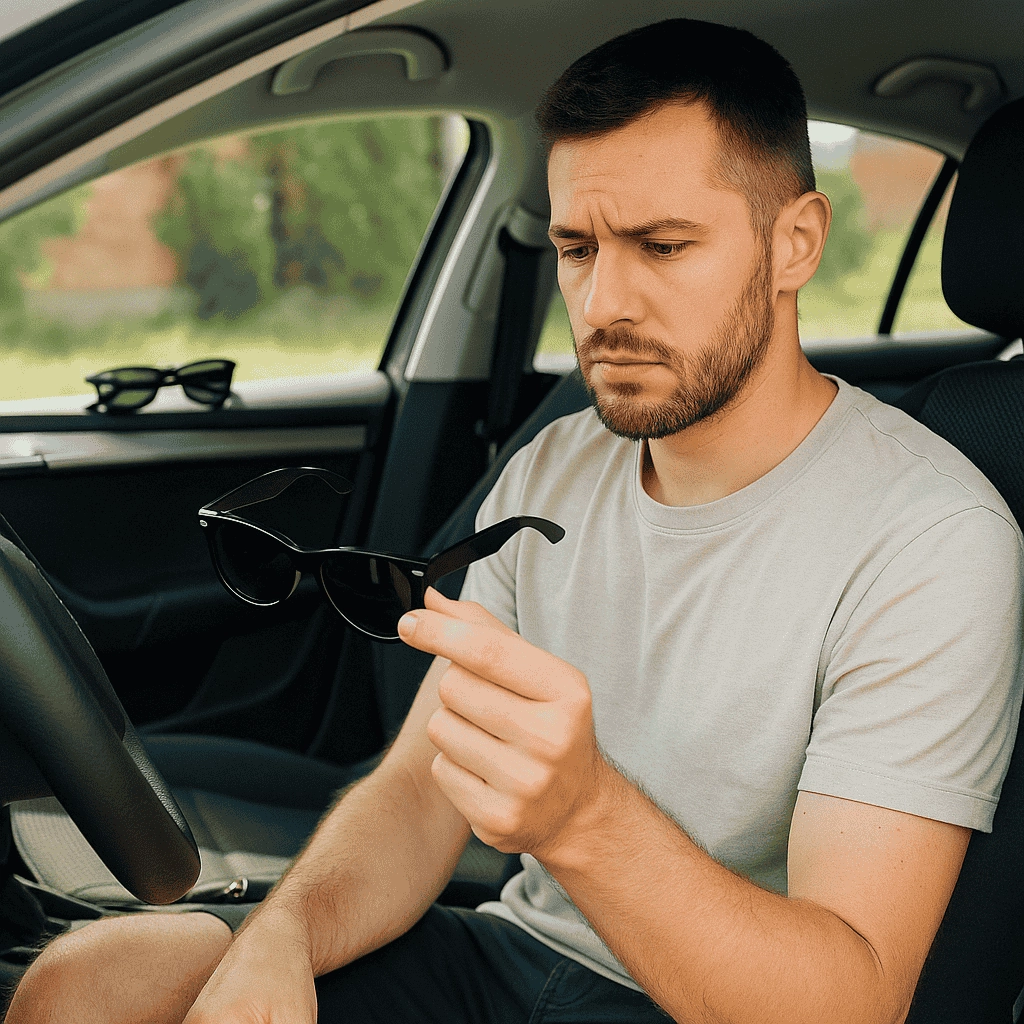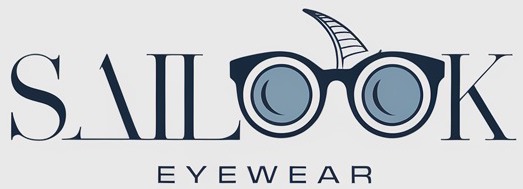Ever wondered if your sunglasses are safe baking in the heat of your car all day?
You’re not alone. Many people toss their sunglasses on the dash or in the console without a second thought. But here’s the kicker—that convenience might be damaging your eyewear faster than you realize. This guide breaks down what really happens to sunglasses left in a car, which materials survive best, and how to store them properly without compromising quality or safety.
Let’s get into it.

1. What happens when sunglasses are left in a hot car?
● Temperatures inside cars can exceed 60°C (140°F) in summer.
● High heat distorts acetate and plastic frames, making them unwearable.
● Lens coatings like polarization or mirror finishes can peel or bubble.
● Dashboards and windshields amplify the problem due to heat concentration.
You might be wondering—how hot is too hot? It depends on the materials. Acetate, common in stylish frames, softens above 50°C. In the oven-like conditions of a parked vehicle, frames can warp unevenly or even separate at the hinges. Metal frames aren’t safe either. They expand and contract, loosening screws and distorting the shape over time.
Even worse, lenses can suffer optical distortion when subjected to prolonged heat. Polarized filters may delaminate, while mirrored coatings lose their reflective layer, leading to blurred vision and reduced effectiveness. That “foggy” look you sometimes see on cheap glasses? Often a result of heat damage.
High-performance sunglasses may handle heat better, but repeated cycles of heating and cooling still reduce their lifespan.
| Material | Heat Damage Risk | Typical Failure |
|---|---|---|
| Acetate | High | Warping, melting |
| Plastic | Medium | Frame distortion |
| Metal (non-Ti) | High | Expansion, loosening |
| Lenses (Coated) | High | Peeling, bubbling |
2. Can leaving sunglasses in a cold car cause damage?
● Cold temperatures stiffen plastic frames, making them brittle.
● Lens coatings can crack due to micro-expansion and contraction.
● Moisture buildup leads to condensation between lens layers.
● Thermal shock is a real risk when bringing cold glasses into warmth.
Let’s be real—it’s not just heat that’s the villain here. Cold temperatures pose a quieter but equally serious threat. Many assume freezing temps “preserve” materials. Not quite. When glasses sit overnight in sub-zero conditions, the plastic becomes rigid and more prone to cracking under minor pressure—especially at the hinges or temples.
Plus, temperature swings create condensation. When cold frames hit warm air (like your face), moisture forms between lenses—especially with layered polarized or photochromic lenses. That trapped moisture can result in foggy optics or fungal growth between lens layers.
Metal frames can contract slightly, changing tension at the hinge or even causing stress fractures. Prescription sunglasses, which require exact optical alignment, may lose their calibration altogether.
| Condition | Risk Factor | Common Result |
|---|---|---|
| Sub-zero cold | Medium | Brittle frames, cracking |
| Humidity shift | High | Condensation, fogging |
| Sudden warming | High | Coating delamination |
3. Which sunglasses materials handle car storage best?
● TR90 and titanium alloy resist heat and cold better than acetate.
● Nylon lenses hold up better than polycarbonate under temperature swings.
● Injection-molded plastics tend to survive better than handmade ones.
● Flexible frame memory plays a role in thermal recovery.
Here’s something nobody tells you—materials matter more than brand names. That sleek pair of designer acetate frames? Gorgeous, but fragile under heat. By contrast, TR90—a memory polymer used in sport eyewear—bends without breaking, even after sitting in a hot car.
Titanium alloys are another winner. These metals resist heat deformation and maintain their shape better than cheaper stainless steel alternatives. For lenses, nylon offers better impact resistance and less warping than standard polycarbonate, especially when treated with heat-stable coatings.
That said, no material is invincible. Even TR90 can degrade over time, especially if combined with lower-grade hinges or coatings. But for daily storage in unpredictable environments, they’ll last much longer.
| Material | Durability in Car | Notes |
|---|---|---|
| TR90 | High | Lightweight and heat resistant |
| Titanium Alloy | Very High | Strong and rust-resistant |
| Nylon Lens | Medium-High | Holds shape well under heat |
| Acetate | Low | Warps quickly in heat |
4. How do UV rays affect sunglasses in the car?
● UV exposure continues even when the car is parked.
● Plastic frames degrade faster under direct sunlight.
● Lens adhesives and filters break down over time.
● Dashboards act like magnifying glasses, intensifying exposure.
This is where it gets interesting—your sunglasses are getting sunburned. Not in the literal sense, of course, but prolonged UV exposure through the windshield accelerates plastic degradation. Over time, plastics become brittle and discolored, especially around the temple tips and nose pads.
UV rays also break down adhesives that bond lenses to frames or hold coating layers together. You’ll notice this as bubbling, yellowing, or “halo” patterns on the lens surface. Even metal frames can suffer, especially if they’re painted or coated.
More alarming? UV rays don’t need direct sunlight. They bounce and scatter inside your car, hitting your glasses from multiple angles—especially when placed near the windshield or rear window.
So even if your car is cool, the light can still damage your eyewear.
5. Can dashboard storage trays or cupholders protect sunglasses?
● Dash trays and cupholders are heat traps, not safe zones.
● Plastic-on-plastic contact causes surface scratches.
● Curved dashboards act like amplifiers for light and heat.
● Better alternatives exist within arm’s reach.
Don’t fall for the “convenience trap.” That recessed tray above the stereo looks like a sunglass holder, but it’s more like a frying pan. These surfaces reach extreme temperatures in direct sunlight, and their contact with hard materials can scuff or flatten curved lenses.
Cupholders aren’t much better. The tight fit often bends temple arms or rubs off nose pad adhesive. Also, the vertical design lets light pour directly onto lenses from above—perfect conditions for heat damage.
Instead, consider using the console box (if lined), glove compartment (if shaded), or overhead bins with soft fabric linings. These offer more controlled environments with less vibration and sun exposure.
6. Do sunglass cases prevent heat-related damage?
● Hard cases protect against physical damage, not heat.
● Fabric linings can reduce thermal shock slightly.
● Soft pouches offer zero heat insulation.
● Some premium cases have heat-resistant shells.
Here’s the brutal truth—cases aren’t miracle workers. Most sunglass cases are designed to protect against crushing, not cooking. Your favorite leather hard case might look luxurious, but leather heats up fast and holds it.
Basic soft pouches? Practically useless in the heat. They offer no thermal barrier and often stick to melting lens coatings. A better choice is a foam-lined hard case with minimal air gaps, preferably stored out of direct sunlight.
Some newer eyewear brands even offer insulated cases with reflective exteriors. These reduce internal temperature spikes and prevent buildup of humidity that causes fogging. But they’re not common—especially in budget models.
| Case Type | Heat Protection | Physical Protection |
|---|---|---|
| Hard-shell EVA | Medium | High |
| Leather Box | Low | High |
| Soft Pouch | Very Low | Very Low |
| Thermal-Lined | High | High |
7. Is it bad to leave prescription sunglasses in your car?
● Prescription lenses are more sensitive to temperature shifts.
● Coatings like anti-reflective or transitions are vulnerable.
● Warped lenses alter optical performance.
● Damage repair costs more than non-Rx sunglasses.
Let’s not sugarcoat it—Rx sunglasses need extra care. They’re more than just fashion; they’re calibrated vision aids. When lenses warp even slightly from heat, your eyesight suffers. You might not notice at first, but eye strain and headaches are clear red flags.
Transition lenses (photochromic) are especially vulnerable. Heat can deactivate their light-changing molecules or cause uneven darkening.
Anti-reflective and blue-light coatings also degrade faster in heat, often peeling or discoloring within months.
Replacing prescription lenses is expensive. Insurance may not cover replacements due to heat damage, which is typically considered user negligence.
8. What’s the risk of theft when storing sunglasses in a car?
● Visible sunglasses attract smash-and-grab thieves.
● Designer or branded eyewear increases risk.
● Certain cases look like wallets or electronics.
● Store in hidden compartments when parked outside.
Here’s a risk you might overlook—thieves love shades. Especially when they’re high-end. That Ray-Ban logo might as well be a target sticker. Even generic sunglasses in a fancy case can look valuable enough to break a window.
If you must leave sunglasses in your car, hide them. Use under-seat drawers, glove compartments, or center consoles. Avoid placing them on seats, dash, or cupholders. Even a $10 pair can cost you a broken window and a headache.
9. What are the best practices for storing sunglasses in a vehicle?
● Keep sunglasses in shaded compartments like glove boxes or center consoles
● Use hard-shell, heat-resistant cases when possible
● Avoid storage spots near the windshield or back window
● Make sunglass removal a daily habit to prevent cumulative damage
Ready for the good part? Let’s talk solutions. Storing your sunglasses in the car doesn’t always have to be a mistake—if you do it right.
The first rule? Avoid visible spots. That means no dashboards, cupholders, or door compartments that get sunlight through side windows. These areas turn into greenhouses and amplify heat and UV damage.
Second, always use a structured case—ideally one that’s insulated or heat-resistant. Some newer automotive accessories now include dedicated sunglass compartments near the overhead console. These often have soft linings and are recessed from sunlight.
If you’re stepping out for just 5–10 minutes, the risk is low. But for anything longer, take your glasses with you or move them to a safer spot. Treat your sunglasses like your phone or laptop—if you wouldn’t leave that on the dash, don’t leave your shades there either.
10. How do luxury vs budget sunglasses compare in durability?
● Luxury frames often use higher-grade acetate or titanium
● Budget frames may skip protective coatings or stable hinges
● Coating adhesion is typically better in premium models
● Brand reputation often correlates with real-world performance
This might surprise you—not all $300 sunglasses are created equal. Nor are all $30 ones destined to fail. But generally, premium eyewear performs better under environmental stress, especially heat and UV exposure.
Brands like Maui Jim or Persol use hand-polished acetate, multi-layer lenses, and high-durability coatings that are bonded using advanced adhesives. These survive heat and temperature fluctuations far better than the spray-on coatings found in cheaper models.
Budget eyewear, while attractive, often uses thin frames, injection-molded lenses, and basic glue. Under prolonged exposure to car heat, these materials soften, separate, or discolor faster. Screws may loosen. Temple arms bend permanently.
Still, some budget sports brands like Blenders or Knockaround use TR90 or polycarbonate designed for durability, meaning price isn’t the only factor—construction method matters too.
11. How does car tinting affect sunglasses left inside?
● Tinted windows reduce UV but not heat completely
● Tinting helps protect frames and coatings from light damage
● IR rejection films offer better heat control
● Sunglasses still need storage in shaded compartments
Let’s clear something up—car tint helps, but doesn’t solve everything. A tinted windshield or side window blocks a percentage of UV rays, depending on the film’s rating. But heat? That’s a different beast.
Unless you’re using ceramic tint with high infrared (IR) rejection, interior temps still rise quickly. Regular dyed or metallic tints may reduce glare but only lower heat slightly.
So yes, tint helps delay damage, especially for lenses sensitive to UV breakdown. But even with the darkest legal tint, sunglass storage must still follow best practices—use shaded areas, insulated cases, and avoid daily exposure near glass panels.
| Tint Type | UV Protection | Heat Protection |
|---|---|---|
| Dyed Tint | Medium | Low |
| Metalized Tint | High | Medium |
| Ceramic IR Tint | Very High | High |
| No Tint | None | None |
12. Can polarized lenses be damaged by car heat?
● Polarized films can delaminate or bubble under high temps
● Heat weakens adhesion between lens layers
● Distorted polarization leads to uneven glare reduction
● Quality polarized lenses last longer under stress
Here’s a quick eye-opener—polarized doesn’t mean indestructible. These lenses are layered, with a polarization filter sandwiched between outer layers. When heat builds up, adhesives soften, and layers start to separate.
You might notice weird patterns, like waves or spots in your vision. That’s not dirt—it’s delamination. Cheap polarized glasses are especially prone to this, as they often use hot-pressed film with minimal bonding agents.
Even high-end models can degrade over time if repeatedly left in hot cars. While brands like Oakley or Smith may last longer, they’re not immune. To protect your polarized lenses, treat them like camera gear—keep them cool, dry, and in their case when not in use.
13. What alternatives are there to leaving sunglasses in the car?
● Keep a backup pair in your everyday bag
● Use visor clips or overhead storage bins
● Store in soft-lined compartments, not visible spaces
● Choose folding sunglasses for easier carry
Here’s a smarter move—plan ahead. If you regularly switch sunglasses, store one pair at home and another in your bag. For drivers, visor-mounted clips offer safe, shaded storage that’s easily accessible but hidden from view.
Some SUVs and sedans include dedicated sunglass holders built into the ceiling—often padded and spring-loaded. These are among the safest in-car spots if you must leave them inside.
Another option? Go compact. Folding sunglasses fit into pocket-sized hard cases and slide neatly into bags or console drawers. That way, you’re never stuck without protection or forced to leave your eyewear behind in risky areas.
14. Are any brands designed for car storage durability?
● Some brands test frames in temperature-controlled environments
● Sports brands use heat-flexible materials like TR90
● Luxury brands may not prioritize heat resistance
● Sailook Eyewear develops heat-tested acetate for OEM partners
This is where brand innovation matters. Some manufacturers design specifically for outdoor and in-car conditions. Oakley, for instance, uses thermoplastic O Matter in sport frames, made to withstand sweat, heat, and impact.
Others, like Costa or Wiley X, use wraparound designs and lens adhesives that tolerate UV and thermal pressure better.
Luxury brands, while premium in style, often prioritize aesthetics over durability. Hand-laminated acetates can separate in high temps, and their coatings aren’t always meant for harsh environments.
Sailook Eyewear offers OEM solutions with temperature-tested materials—blending the strength of TR90 and custom acetate formulas. These frames resist deformation, and we offer specialized coatings that withstand heat and UV exposure. If you’re building a sunglass line for warm climates or active users, this matters.
15. How can Sailook Eyewear help with heat-resistant sunglasses?
● Custom materials like TR90 or reinforced acetate for thermal stability
● Polarized lenses with anti-delamination coatings
● Case design guidance for sunglass brands targeting outdoor use
● Low-MOQ sampling for startup brands testing hot-climate durability
Let’s bring it home. Sailook Eyewear doesn’t just manufacture frames—we solve real-world usage issues. If your market includes drivers, beachgoers, or outdoor workers, you need sunglasses that can survive environmental stress.
Our technical team tests materials for flexibility, UV resistance, and coating integrity under simulated heat conditions. We help you choose the right frame shape, material, and lens combo—not just for style, but for lasting performance.
Need support for your brand’s next sunglass collection? We offer customization, branding, low MOQ sampling, and professional export compliance. Sunglasses that can survive the car—and still look good doing it.
Final Thoughts
Leaving sunglasses in the car isn’t just a small habit—it’s a decision that affects longevity, clarity, and performance. We’ve covered how heat, cold, UV rays, and even theft can damage or shorten the life of your eyewear.
Want your sunglasses to last?
Use shaded compartments. Invest in thermal-resistant cases. Choose materials built to perform. And if you’re developing your own sunglass brand—work with a supplier that understands environmental challenges.
Because when your product works in the harshest conditions, your customers stay loyal.
FAQ
- Q1: What is the risk of storing sunglasses in a car?
Leaving sunglasses in a car exposes them to extreme heat, UV rays, and temperature fluctuations, which can cause warping, coating damage, and even cracking of lenses or frames. - Q2: How does heat affect sunglass lenses?
Heat softens lens adhesives and coating layers, leading to bubbling, fogging, or delamination—especially with polarized or mirrored lenses. - Q3: Are all sunglass materials equally heat-resistant?
No. Materials like TR90 and titanium resist heat better than acetate or cheap plastic. Coated lenses are also more vulnerable unless treated with durable finishes. - Q4: Can sunglass cases fully prevent damage from heat?
No. Most cases protect from impact, not temperature. Insulated or thermally lined cases help but aren’t foolproof in parked cars during hot weather. - Q5: What’s the best way to store sunglasses safely in a car?
Store them in shaded, enclosed compartments (like glove boxes) using hard-shell cases. Avoid open surfaces like dashboards or cupholders. Remove them when possible.

